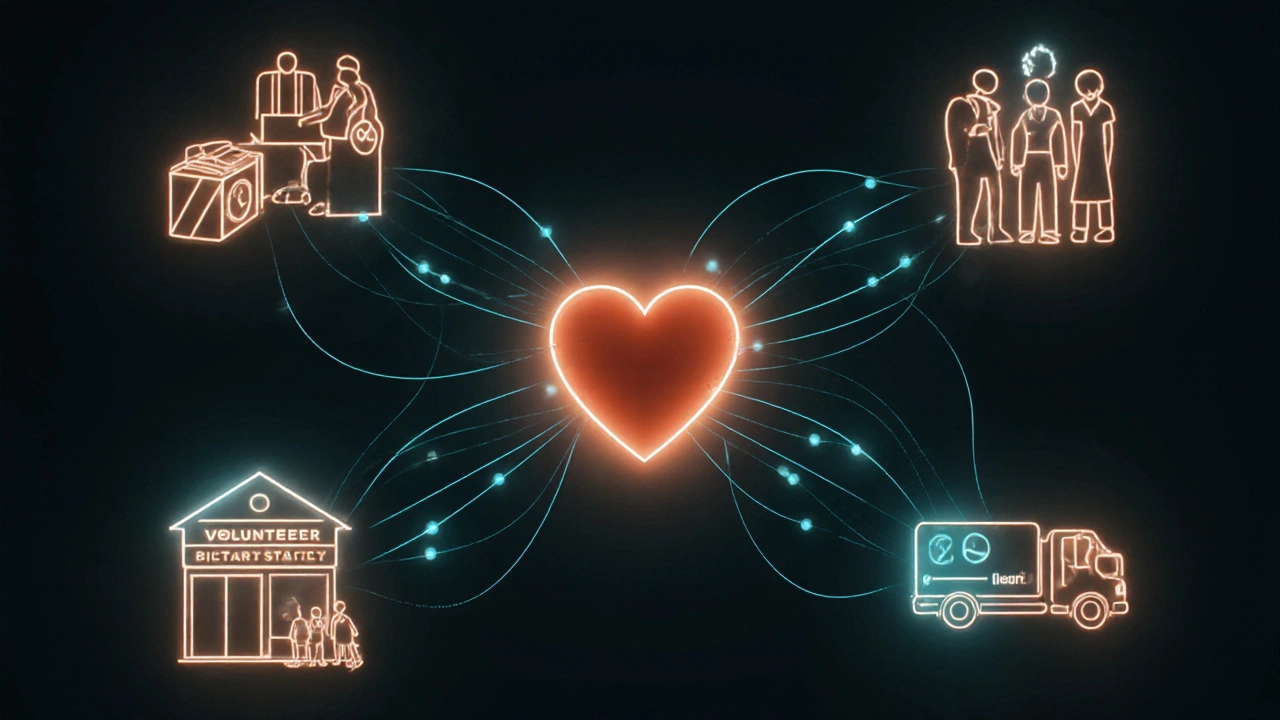Charity Impact Calculator
How Your Support Makes a Difference
Charities don't just collect donations—they transform them into real impact. This calculator shows how your time and money can help address community needs based on real charity operations.
Your Impact
How This Works
Based on real charity operations from the article:
Each activity is modeled after actual charity work described in the article, including examples like Bristol's St. Monica's Food Bank serving 8,000 meals monthly.
When you think of a charity, you might picture people handing out food or raising money at a street stall. But the real work behind a charity goes far beyond that. Charities don’t just collect donations-they plan, organize, and carry out dozens of activities every single day to make a difference. These aren’t just feel-good moments. They’re structured, ongoing efforts that change lives, fix problems, and build stronger communities.
Direct Support Services
At the heart of most charities are direct support services. These are the hands-on actions that meet immediate needs. Think food distribution at local pantries, emergency shelter for people without homes, or free medical clinics in underserved areas. In Bristol, charities like the St. Monica’s Food Bank serve over 8,000 meals a month to families who can’t afford groceries. That’s not a one-off event-it’s a daily operation with volunteers sorting donations, packing boxes, and delivering to people who can’t leave their homes.
Charities also offer counseling, legal aid, and crisis intervention. For example, domestic violence charities don’t just offer a place to sleep-they provide court advocacy, therapy sessions, and help with restraining orders. These aren’t side projects. They’re essential services that fill gaps the government can’t always cover.
Community Outreach and Education
Many charities spend just as much time teaching as they do helping. They run workshops on financial literacy, health screenings, or how to access government benefits. A charity focused on youth might offer after-school programs that teach job skills, while one working with older adults might run dementia awareness sessions in community centers.
In Bristol, the Community Connect Initiative partners with local libraries to host free workshops on digital skills for seniors. They teach people how to use online banking, video calls with family, and book medical appointments. These aren’t glamorous, but they prevent isolation and keep people independent longer.
Education also means changing public perception. Charities fighting stigma around mental health run school talks, social media campaigns, and public art projects. They don’t wait for people to ask for help-they go out and make sure help is visible and approachable.
Advocacy and Policy Work
Not all charity work happens on the ground. A big part of what charities do is push for change at the system level. They collect data, write reports, and meet with politicians to argue for better laws. For instance, charities that support homeless people don’t just give out blankets-they campaign for more social housing, fairer benefits, and protections against eviction.
The Homeless Link network in the UK has helped shape national policy by tracking how many people sleep rough each year. Their data led to new funding for emergency shelters in 12 cities. That’s charity work too: turning stories into statistics, and statistics into laws.

Fundraising and Resource Management
Every charity needs money to keep going. But fundraising isn’t just about running marathons or selling raffle tickets. It’s a full-time job involving grant writing, donor relations, corporate partnerships, and digital campaigns.
A small local charity might rely on weekly coffee mornings and church collections. A larger one might hire a development officer to apply for EU or NHS grants. Some charities run social enterprises-like a thrift store or café-where profits fund their mission. The Salvation Army runs over 300 thrift shops in the UK. Every item sold helps pay for their homeless shelters.
Managing resources is just as important. Charities track every pound spent. They report to regulators like the Charity Commission. They audit their spending. They’re held to higher standards than most businesses because they’re trusted with public money.
Volunteer Coordination
Charities don’t run on paid staff alone. They run on volunteers. But managing volunteers isn’t as simple as asking for help. It requires training, scheduling, background checks, and ongoing support.
A charity running a youth mentoring program doesn’t just pair a teenager with an adult. They screen mentors, give them child protection training, provide lesson plans, and check in weekly. They need to make sure the volunteer feels supported, not burned out.
In Bristol, the Green Action Trust coordinates over 500 volunteers a year for park cleanups and tree planting. They don’t just show up on a Saturday-they offer toolkits, insurance, first aid training, and even free tea and biscuits. That’s how they keep people coming back.
Monitoring and Evaluation
Good charities don’t just do things-they measure whether they’re making a difference. They survey beneficiaries, track outcomes, and adjust their programs based on what works.
For example, a charity helping unemployed people find jobs doesn’t just hand out CV templates. They track how many people get hired after six months, what kind of jobs, and whether they keep them. If only 20% find work, they ask: Is the training wrong? Are employers biased? Do we need to partner with local businesses?
This data gets shared publicly. The Charity Commission requires annual reports. Many charities publish impact statements online. Transparency isn’t optional-it’s part of their job.

Partnerships and Collaboration
No charity works alone. They team up with schools, hospitals, councils, and even businesses. A charity focused on food insecurity might partner with a supermarket chain to collect unsold produce. A mental health charity might work with GPs to refer patients.
In Bristol, the FoodCycle program partners with restaurants, bakeries, and community centers. They collect surplus food, cook meals in volunteer kitchens, and serve them in local halls. Without those partnerships, they couldn’t feed over 1,500 people a week.
These collaborations stretch resources further. They avoid duplication. And they make sure help reaches people who might not even know they need it.
Emergency Response and Crisis Work
When disasters strike-floods, fires, or economic crashes-charities are often the first on the scene. They don’t wait for government orders. They mobilize.
During the 2023 floods in Somerset, local charities delivered hot meals, temporary housing, and emotional support within hours. They used their existing networks-churches, community halls, volunteer lists-to act faster than official agencies could.
Charities also respond to quieter crises: a sudden job loss, a family breakdown, or a mental health emergency. Their flexibility lets them respond to needs that fall through the cracks of public services.
What Makes Charity Activities Different?
What sets charity activities apart isn’t the type of work-it’s the why. Charities don’t do things because they’re profitable. They do them because they’re necessary. They serve people who are often invisible. They take on tasks no one else will. And they do it without expecting anything in return.
It’s not about grand gestures. It’s about showing up, day after day, with no fanfare. It’s the volunteer who drives an elderly person to their dialysis appointment. The teacher who stays late to help a child with homework. The team that sorts donated clothes at 7 a.m. on a freezing Saturday.
That’s what charity really is: quiet, consistent, and deeply human work.
Do all charities run events?
No, not all charities run events. While events like charity runs or galas are common, many charities focus on direct services like food distribution, counseling, or advocacy without ever holding a public event. Events are just one tool-not the core of charity work.
Can a charity operate without volunteers?
Technically yes, but it’s rare and unsustainable. Most charities rely on volunteers for at least half their operations. Paid staff handle management and core services, but volunteers make scaling possible. Without them, even large charities couldn’t reach their full potential.
How do charities decide what activities to do?
They start by listening. They survey the people they serve, talk to community leaders, and study local needs. Some follow national trends, like rising food insecurity. Others respond to local crises, like a factory closing that left hundreds jobless. Their mission statement guides them, but real needs shape their actions.
Are charity activities regulated?
Yes. In the UK, all registered charities must report to the Charity Commission. They must show how they spend money, what they achieve, and how they’re governed. Unregistered groups can still operate, but they can’t raise public funds legally or claim tax relief. Regulation keeps charities accountable.
What’s the biggest challenge charities face in their activities?
Funding instability. Many charities depend on short-term grants or seasonal donations. When a grant ends or a fundraiser underperforms, programs get cut. That means they can’t plan ahead, hire staff long-term, or invest in better systems. It’s exhausting and limits their impact.
